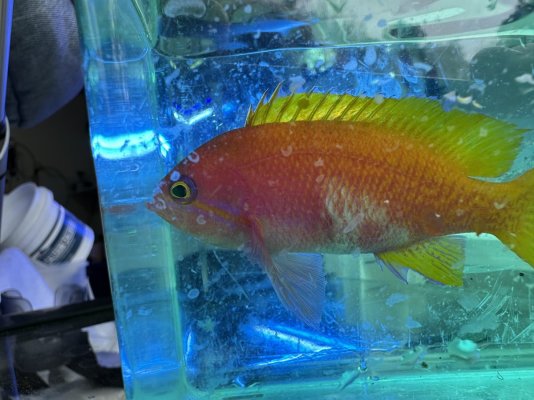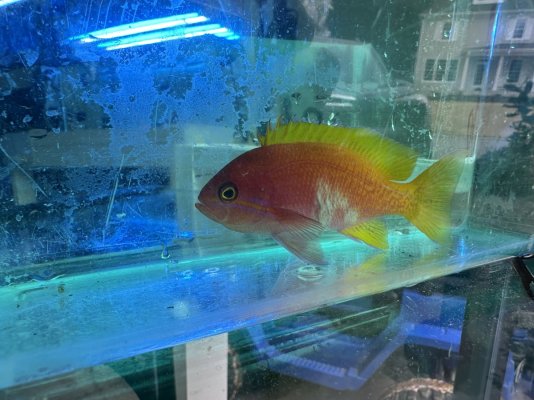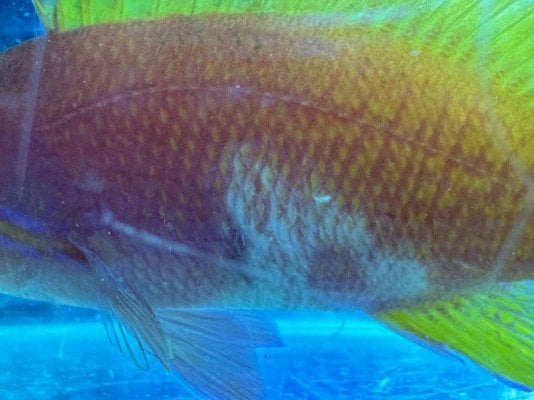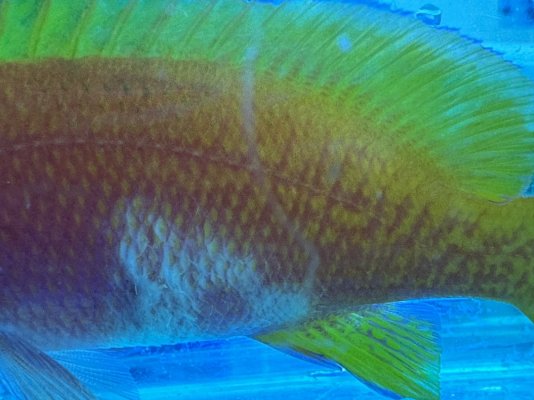Navigation
Install the app
How to install the app on iOS
Follow along with the video below to see how to install our site as a web app on your home screen.
Note: This feature may not be available in some browsers.
More options
You are using an out of date browser. It may not display this or other websites correctly.
You should upgrade or use an alternative browser.
You should upgrade or use an alternative browser.
Seachem StressGuard Reef Safe?
- Thread starter LobsterOfJustice
- Start date
- Tagged users None
Devil’s advocate - why would you want to add this or any “bandage in a bottle” to a reef tank?Has anyone used SEACHEM StressGuard in a reef tank, particularly with acropora?
The very basic issue with all of these products is that they are NOT a medication for fish. The idea that a slime coat will somehow coat fish skin injuries, but not their gills is a fallacy.
If your fish have an acute issue, they need an actual treatment. If they don’t have an acute problem, then they don’t need anything added to the tank.
I managed a medium sized public aquarium for over 30 years and never needed any of those products.
Jay
- Joined
- Sep 20, 2018
- Messages
- 1,225
- Reaction score
- 1,200
It contains glutaraldehyde so no thanks.
This is an obvious oversimplification. Of course it’s easier said than done. There is always the decision to weigh the pros and cons (to the whole system, not just the fish in question) of removing the fish from the system, which at best will involve stressing out this and all other fish by chasing them around with nets traps sticks etc. for minutes? Hours? Days? Or at worst involve stressing every last inhabitant in the tank by removing corals and ripping apart the reef. Of course if I could snap my fingers and the fish would teleport into a hospital tank that would be my choice. I am working on catching the fish but catching two Anthias out of a 180 gallon tank that’s been established for seven years is not easy. So to answer your question, the reason I would want to add this product to a reef tank is so that at least I can be trying SOMETHING, doing SOMETHING, while also in the meantime working on getting these fish out in a way that does not cause more harm than good to them and the rest of the system.
I’m happy for you that somehow over thirty years managing a public aquarium you were somehow never in a situation where you needed to weigh the pros and cons and make a decision on whether or not to remove a fish from the tank for treatment .
.
I’m happy for you that somehow over thirty years managing a public aquarium you were somehow never in a situation where you needed to weigh the pros and cons and make a decision on whether or not to remove a fish from the tank for treatment
Devil’s advocate - why would you want to add this or any “bandage in a bottle” to a reef tank?
The very basic issue with all of these products is that they are NOT a medication for fish. The idea that a slime coat will somehow coat fish skin injuries, but not their gills is a fallacy.
If your fish have an acute issue, they need an actual treatment. If they don’t have an acute problem, then they don’t need anything added to the tank.
I managed a medium sized public aquarium for over 30 years and never needed any of those products.
Jay
This is an obvious oversimplification. Of course it’s easier said than done. There is always the decision to weigh the pros and cons (to the whole system, not just the fish in question) of removing the fish from the system, which at best will involve stressing out this and all other fish by chasing them around with nets traps sticks etc. for minutes? Hours? Days? Or at worst involve stressing every last inhabitant in the tank by removing corals and ripping apart the reef. Of course if I could snap my fingers and the fish would teleport into a hospital tank that would be my choice. I am working on catching the fish but catching two Anthias out of a 180 gallon tank that’s been established for seven years is not easy. So to answer your question, the reason I would want to add this product to a reef tank is so that at least I can be trying SOMETHING, doing SOMETHING, while also in the meantime working on getting these fish out in a way that does not cause more harm than good to them and the rest of the system.
I’m happy for you that somehow over thirty years managing a public aquarium you were somehow never in a situation where you needed to weigh the pros and cons and make a decision on whether or not to remove a fish from the tank for treatment.
Sorry if I sounded elitist about my not using those products in my career as an aquarium curator, but my point was: these do not treat acute diseases, and I've never used them in that capacity. I DID sell a ton of them back when I managed a pet store, but that was because people asked for them, so I would make the sale.
What is the issue you are trying to treat? There are a few reef safe medications that actually work against some acute infections (I'm using acute here to mean that a fish will die without treatment).
If you'd like the Fish Medics to weigh in on possible treatments, you can post a "problem report" using these instructions:

Some Helpful Hints When Posting or Responding to Threads in the Fish Disease Treatment and Diagnosis Section
Aquarium Fish Disease Problem Solving Determining the best course of action for a problem with your aquarium can be a difficult task. Even advanced aquarists will often need to seek the help of others for complicated or unique issues. Our intent here on Reef 2 Reef is to offer expert advice...
 www.reef2reef.com
www.reef2reef.com
Jay
Sorry if I got defensive a little quickly too.
Two days ago I noticed one bimac anthias with fin rot on the pectoral fins. The next day (yesterday), it had spread to the abdomen (where the pectoral fin touches the body), and a second anthias was showing fin rot on a pectoral fin. Amazingly I was able to catch the worse of the two which is now in a hospital tank with NFG, but after about an hour of trying to catch the other, I made the judgement call that stressing everyone out was doing more harm than good. Today, the anthias which is still in the DT looks no worse, but a Small Tail Pencil Wrasse is showing cloudy patches on its body.
No idea where this came from. No fish have been added to the system since November and all fish were quarantined. The bimacs have been in the tank since last September and the wrasse I've had for several years. This is an established successful SPS tank so in general this is a well cared for system with high water quality. I also run UV (changed in November) and I have been running ozone since early Feb.
I have antibiotics on hand and I'm pretty confident I could have this under control if I could just get the fish into the hospital tank (to be honest, all my experience is treating new fish in QT/hospital settings, I'm not used to having issues on my established fish in the DT).
Two days ago I noticed one bimac anthias with fin rot on the pectoral fins. The next day (yesterday), it had spread to the abdomen (where the pectoral fin touches the body), and a second anthias was showing fin rot on a pectoral fin. Amazingly I was able to catch the worse of the two which is now in a hospital tank with NFG, but after about an hour of trying to catch the other, I made the judgement call that stressing everyone out was doing more harm than good. Today, the anthias which is still in the DT looks no worse, but a Small Tail Pencil Wrasse is showing cloudy patches on its body.
No idea where this came from. No fish have been added to the system since November and all fish were quarantined. The bimacs have been in the tank since last September and the wrasse I've had for several years. This is an established successful SPS tank so in general this is a well cared for system with high water quality. I also run UV (changed in November) and I have been running ozone since early Feb.
I have antibiotics on hand and I'm pretty confident I could have this under control if I could just get the fish into the hospital tank (to be honest, all my experience is treating new fish in QT/hospital settings, I'm not used to having issues on my established fish in the DT).
Fin rot doesn’t really start up spontaneously, it always has a root cause. Aside from fin damage seen in some fish with HLLE, fin damage always has some mechanical cause: tankmate aggression, mechanical damage from transfers, etc. or flukes. If there is a secondary infection involved and if the original cause can be eliminated, then antibiotics are helpful in resolving this.Sorry if I got defensive a little quickly too.
Two days ago I noticed one bimac anthias with fin rot on the pectoral fins. The next day (yesterday), it had spread to the abdomen (where the pectoral fin touches the body), and a second anthias was showing fin rot on a pectoral fin. Amazingly I was able to catch the worse of the two which is now in a hospital tank with NFG, but after about an hour of trying to catch the other, I made the judgement call that stressing everyone out was doing more harm than good. Today, the anthias which is still in the DT looks no worse, but a Small Tail Pencil Wrasse is showing cloudy patches on its body.
No idea where this came from. No fish have been added to the system since November and all fish were quarantined. The bimacs have been in the tank since last September and the wrasse I've had for several years. This is an established successful SPS tank so in general this is a well cared for system with high water quality. I also run UV (changed in November) and I have been running ozone since early Feb.
I have antibiotics on hand and I'm pretty confident I could have this under control if I could just get the fish into the hospital tank (to be honest, all my experience is treating new fish in QT/hospital settings, I'm not used to having issues on my established fish in the DT).
If you post a video, I might be able to tell you more.
The anthias look pretty good really, just some minor issues.
The wrasse is pretty damaged, I'm not sure from what. The eroded second dorsal fin is an odd spot - fish typically bite others on the caudal or pectoral fins. The wrasse does seem to have some disrupted scales on its body that could also be bites.
Sometimes - you can determine the culprit by picking the one fish that has no fin damage or lesions. Other times, you can try putting your phone to video the tank and then leave the room (fish will often stop fighting while you are in the room). However, be forewarned that this fighting can be very transient - one of two bites each day can really add to the damage, but are literally over in a split second, you may not even see it happen.
Jay
The wrasse is pretty damaged, I'm not sure from what. The eroded second dorsal fin is an odd spot - fish typically bite others on the caudal or pectoral fins. The wrasse does seem to have some disrupted scales on its body that could also be bites.
Sometimes - you can determine the culprit by picking the one fish that has no fin damage or lesions. Other times, you can try putting your phone to video the tank and then leave the room (fish will often stop fighting while you are in the room). However, be forewarned that this fighting can be very transient - one of two bites each day can really add to the damage, but are literally over in a split second, you may not even see it happen.
Jay
Yeah, I typically wouldn’t be worried with this level of damage to the Anthias fins, except for the fact that the other one seemed to progress really quickly overnight to a point that I felt I needed to intervene. I don’t have a picture of that one because she’s hiding in a tube in QT.
Here’s the one I was able to remove. Has been in NFG for 3 days but is not eating. The fish in the tank seem to be looking better. I am lacing their food with kanaplex but I don’t know if that’s actually helping.
Attachments
- Joined
- Sep 20, 2018
- Messages
- 1,225
- Reaction score
- 1,200
Here’s the one I was able to remove. Has been in NFG for 3 days but is not eating. The fish in the tank seem to be looking better. I am lacing their food with kanaplex but I don’t know if that’s actually helping.
Kanamycin has extremely low oral bioavailability.
And it is also reported by Noga to be toxic in some cases. He gives an oral dose of 50 mg/kg.Kanamycin has extremely low oral bioavailability.
Whoa - that’s really ugly.
As I think I mentioned, with these sorts of infections, unless you do a microscopic skin scrape, you can’t rule out Uronema or mixed Uronema/bacterial infections.
With this infection taking up such a relative high percentage of fish body area, osmoregulation becomes a huge problem. You might want to consider lowering the specific gravity to be more in line with the fish’s blood - say 1.019 or so.
Similar threads
- Question
- Replies
- 15
- Views
- 343
- Replies
- 3
- Views
- 119
- Replies
- 6
- Views
- 138























